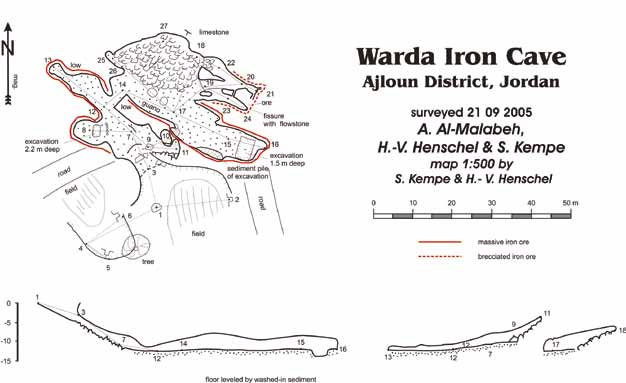The Possibly Hypogene Karstic Iron Ore Deposit of Warda Near Ajloun (Northern Jordan), its Mineralogy, Geochemistry and Historic Mine
DOI:
https://doi.org/10.3986/ac.v37i2-3.149Povzetek
In this study the iron ore deposit of the historic Warda mine (District of Ajloun, Northern Jordan) and its speleological importance is discussed. The number of known dissolutional caves in Jordan is very low, in spite of the fact, that large sections of the country are underlain by Cretaceous limestone. The only large cave yet discovered is Al-Daher Cave, a hypogene maze cave (Kempe et al. 2006). The Warda Iron Deposit was mined during the time of the crusades by one of Saladin’s officers to build and stock the castle of Ajloun. The survey shows that the mine consists of two larger rooms, together about 1000 m2 in area. Much of the mine’s floor is now covered with recent flood sediments (680 m2), up to over 2 m deep. The mine cuts natural cavities, fissures with speleothems and a collapse hall in limestone, that may or may not have been created by a collapsed mine ceiling. Calculating the mine volume conservatively, a total of about 1100 t of elemental iron may have been extracted. Mineralogical investigation (XRD) shows, that the iron ore is goethitic/limonitic with noticeable hematite contents. Geochemical (XRF) analysis shows that the goethite is very pure; impurities of main elements sum up to 1% only. Among the trace-elements W (248 ppm), As (168 ppm) and Co (124 ppm) show the highest concentrations, with all others < 37 (Ba) ppm. Former prospecting results show that the deposit has a spatial extent of 300 x 200 m with a maximal thickness of about 10 m. Textural, mineralogical and geochemical criteria suggest that the ore body could be of speleogene origin, i.e. deposited in a hypogene, deep phreathic setting, possibly before regional uplift or even prior to the maximal burial depth. A possibly similar ore-body is for example described from the gigantic Lower Cretaceous and sand-filled cave of Wülfrath (North Rhine-Westphalia, Germany) (Drozdzewski et al. 1998).
Prenosi

Prenosi
Objavljeno
Kako citirati
Številka
Rubrike
Licenca
Avtorji jamčijo, da je delo njihova avtorska stvaritev, da v njem niso kršene avtorske pravice tretjih oseb ali kake druge pravice. V primeru zahtevkov tretjih oseb se avtorji zavezujejo, da bodo varovali interese založnika ter da bodo povrnili morebitno škodo.
Podrobneje v rubriki: Prispevki




